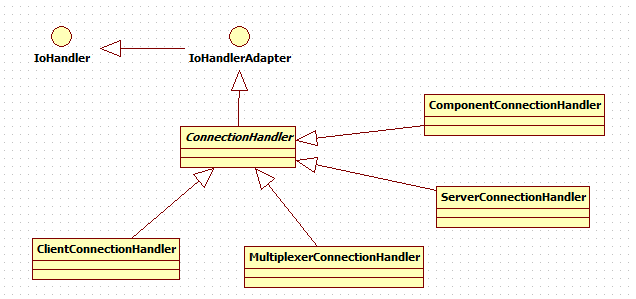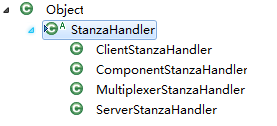Openfire的启动过程与session管理
Class containerClass = loader.loadClass("org.jivesoftware.openfire.XMPPServer");
containerClass.newInstance();
- 初始化配置参数
- 检查是否需要安装
- 初始化Module
- 启动统计模块
- 启动plugin
if (!setupMode) {
verifyDataSource();
// First load all the modules so that modules may access other modules while
// being initialized
loadModules();
// Initize all the modules
initModules();
// Start all the modules
startModules();
}
public interface Module {
/**
* Returns the name of the module for display in administration interfaces.
*
* @return The name of the module.
*/
String getName();
/**
* Initialize the module with the container.
* Modules may be initialized and never started, so modules
* should be prepared for a call to destroy() to follow initialize().
*
* @param server the server hosting this module.
*/
void initialize(XMPPServer server);
/**
* Start the module (must return quickly). Any long running
* operations should spawn a thread and allow the method to return
* immediately.
*/
void start();
/**
* Stop the module. The module should attempt to free up threads
* and prepare for either another call to initialize (reconfigure the module)
* or for destruction.
*/
void stop();
/**
* Module should free all resources and prepare for deallocation.
*/
void destroy();
}
// Load this module always last since we don't want to start listening for clients
// before the rest of the modules have been started
loadModule(ConnectionManagerImpl.class.getName());
private final ConnectionListener clientListener;
private final ConnectionListener clientSslListener;
private final ConnectionListener boshListener;
private final ConnectionListener boshSslListener;
private final ConnectionListener serverListener;
private final ConnectionListener componentListener;
private final ConnectionListener componentSslListener;
private final ConnectionListener connectionManagerListener; // Also known as 'multiplexer'
private final ConnectionListener connectionManagerSslListener; // Also known as 'multiplexer'
private final ConnectionListener webAdminListener;
private final ConnectionListener webAdminSslListener;
- client:表示客户端连接
- bosh:就是HTTP绑定的连接
- server:服务器到服务器的socket连接
- component:组件到服务器的连接
- connectionManager:是指通过connectionManager连接器过来的连接
- webAdmin:是指web控制台的连接
if ( getType() == ConnectionType.SOCKET_S2S )
{
connectionAcceptor = new LegacyConnectionAcceptor( generateConnectionConfiguration() );
}
else
{
connectionAcceptor = new MINAConnectionAcceptor( generateConnectionConfiguration() );
}




@Override
StanzaHandler createStanzaHandler(NIOConnection connection) {
return new ClientStanzaHandler(XMPPServer.getInstance().getPacketRouter(), connection);
}
@Override
public void sessionOpened(IoSession session) throws Exception {
// Create a new XML parser for the new connection. The parser will be used by the XMPPDecoder filter.
final XMLLightweightParser parser = new XMLLightweightParser(StandardCharsets.UTF_8);
session.setAttribute(XML_PARSER, parser);
// Create a new NIOConnection for the new session
final NIOConnection connection = createNIOConnection(session);
session.setAttribute(CONNECTION, connection);
session.setAttribute(HANDLER, createStanzaHandler(connection));
// Set the max time a connection can be idle before closing it. This amount of seconds
// is divided in two, as Openfire will ping idle clients first (at 50% of the max idle time)
// before disconnecting them (at 100% of the max idle time). This prevents Openfire from
// removing connections without warning.
final int idleTime = getMaxIdleTime() / 2;
if (idleTime > 0) {
session.getConfig().setIdleTime(IdleStatus.READER_IDLE, idleTime);
}
}
这样每一个session在打开时都会设置handler,而具体的handler由各个派生类创建返回。这里的StanzHandler就是Openfire里的数据包处理单元。和connection类型一样,包处理也是对应的几个类:


@Override
public void messageReceived(IoSession session, Object message) throws Exception {
// Get the stanza handler for this session
StanzaHandler handler = (StanzaHandler) session.getAttribute(HANDLER);
// Get the parser to use to process stanza. For optimization there is going
// to be a parser for each running thread. Each Filter will be executed
// by the Executor placed as the first Filter. So we can have a parser associated
// to each Thread
final XMPPPacketReader parser = PARSER_CACHE.get();
// Update counter of read btyes
updateReadBytesCounter(session);
//System.out.println("RCVD: " + message);
// Let the stanza handler process the received stanza
try {
handler.process((String) message, parser);
} catch (Exception e) {
Log.error("Closing connection due to error while processing message: " + message, e);
final Connection connection = (Connection) session.getAttribute(CONNECTION);
if ( connection != null ) {
connection.close();
} }
}
在接收到数据包后获取到StanzaHandler,然后调用了它的process方法,也就是让实际的包处理者去处理数据。这样就回到了StanzeHanler,以ClientStanzaHandler为例子。只不过这个派生类中没有重写process方法,也就是说要看父类的实现:
public void process(String stanza, XMPPPacketReader reader) throws Exception {
boolean initialStream = stanza.startsWith("<stream:stream") || stanza.startsWith("<flash:stream");
if (!sessionCreated || initialStream) {
if (!initialStream) {
..........
// Found an stream:stream tag...
if (!sessionCreated) {
sessionCreated = true;
MXParser parser = reader.getXPPParser();
parser.setInput(new StringReader(stanza));
createSession(parser);
}
..........
return;
}
..........
}
由于代码较多,我省略了一些代码。看到这应该明白了吧,对于当前的连接没有创建Openfire的session对象时,会进行创建过程createSession,对于不同的StanzeHandler会有些不一样,这里ClientStanzaHandler的实现就是把创建好的session放到本地的LocalClientSession中:
@Override
boolean createSession(String namespace, String serverName, XmlPullParser xpp, Connection connection)
throws XmlPullParserException {
if ("jabber:client".equals(namespace)) {
// The connected client is a regular client so create a ClientSession
session = LocalClientSession.createSession(serverName, xpp, connection);
return true;
}
return false;
}
public ClientSession getSession(JID from) {
// Return null if the JID is null or belongs to a foreign server. If the server is
// shutting down then serverName will be null so answer null too in this case.
if (from == null || serverName == null || !serverName.equals(from.getDomain())) {
return null;
}
// Initially Check preAuthenticated Sessions
if (from.getResource() != null) {
ClientSession session = localSessionManager.getPreAuthenticatedSessions().get(from.getResource());
if (session != null) {
return session;
}
}
if (from.getResource() == null || from.getNode() == null) {
return null;
}
return routingTable.getClientRoute(from);
}
先是获取本地的session,如果能找到直接返回,找不到则跳到routingTable里获取客户端的路由信息。
@Override
public ClientSession getClientRoute(JID jid) {
// Check if this session is hosted by this cluster node
ClientSession session = (ClientSession) localRoutingTable.getRoute(jid.toString());
if (session == null) {
// The session is not in this JVM so assume remote
RemoteSessionLocator locator = server.getRemoteSessionLocator();
if (locator != null) {
// Check if the session is hosted by other cluster node
ClientRoute route = usersCache.get(jid.toString());
if (route == null) {
route = anonymousUsersCache.get(jid.toString());
}
if (route != null) {
session = locator.getClientSession(route.getNodeID().toByteArray(), jid);
}
}
}
return session;
}
这里更直接的可以看到,查找本地路由不null则会通过RemoteSessionLocator来完成。当然这里最大的奥秘其实是usersCache和anonymousUsersCache这两个cache。之前写的集群源码分析中提过,最终openfire集群后会对缓存进行同步,这样每台服务器上都会有缓存的副本。所以usersCache是拥有所有用户信息的,有了user的信息就有了jid的信息,这样不管是哪台服务器都可以对数据包处理并发送给客户端。
public Collection<ClientSession> getSessions() {
return routingTable.getClientsRoutes(false);
}
其实就是访问路由表,因为路由表里有所有的cache,和获取单个的session不一样,需要对所有的路由都遍历返回。
@Override
public Collection<ClientSession> getClientsRoutes(boolean onlyLocal) {
// Add sessions hosted by this cluster node
Collection<ClientSession> sessions = new ArrayList<ClientSession>(localRoutingTable.getClientRoutes());
if (!onlyLocal) {
// Add sessions not hosted by this JVM
RemoteSessionLocator locator = server.getRemoteSessionLocator();
if (locator != null) {
// Add sessions of non-anonymous users hosted by other cluster nodes
for (Map.Entry<String, ClientRoute> entry : usersCache.entrySet()) {
ClientRoute route = entry.getValue();
if (!server.getNodeID().equals(route.getNodeID())) {
sessions.add(locator.getClientSession(route.getNodeID().toByteArray(), new JID(entry.getKey())));
}
}
// Add sessions of anonymous users hosted by other cluster nodes
for (Map.Entry<String, ClientRoute> entry : anonymousUsersCache.entrySet()) {
ClientRoute route = entry.getValue();
if (!server.getNodeID().equals(route.getNodeID())) {
sessions.add(locator.getClientSession(route.getNodeID().toByteArray(), new JID(entry.getKey())));
}
}
}
}
return sessions;
}
Openfire的启动过程与session管理的更多相关文章
- cocos2dx 解释二具体的启动过程:内存管理和回调
在上一篇的第二部分中.我们有一句代码待解释的: // Draw the Scene void CCDirector::drawScene(void) { -... //tick before ...
- 启动期间的内存管理之初始化过程概述----Linux内存管理(九)
在内存管理的上下文中, 初始化(initialization)可以有多种含义. 在许多CPU上, 必须显式设置适用于Linux内核的内存模型. 例如在x86_32上需要切换到保护模式, 然后内核才能检 ...
- tomcat架构分析 (Session管理)
Session管理是JavaEE容器比较重要的一部分,在app中也经常会用到.在开发app时,我们只是获取一个session,然后向session中存取数据,然后再销毁session.那么如何产生se ...
- 使用Memcached Session Manager扩展Session管理
>>Tomcat的session管理 在请求过程中首先要解析请求中的sessionId信息,然后将sessionId存储到request的参数列表中. 然后再从request获取sessi ...
- Tomcat的Session管理机制
>>Session和Cookie请求的过程 Http连接本身是无状态的,即前一次发起的连接跟后一次没有任何关系,是属于两次独立的连接请求,但是互联网访问基本上都是需要有状态的,即服务器需要 ...
- Nginx学习笔记(六) 源码分析&启动过程
Nginx的启动过程 主要介绍Nginx的启动过程,可以在/core/nginx.c中找到Nginx的主函数main(),那么就从这里开始分析Nginx的启动过程. 涉及到的基本函数 源码: /* * ...
- How Tomcat works — 八、tomcat中的session管理
在使用shiro的session的时候感觉对于tomcat中session的管理还不是特别清楚,而且session管理作为tomcat中比较重要的一部分还是很有必要学习的. 目录 概述 session ...
- Linux X Window System运行原理和启动过程
本文主要说明X Window System的基本运行原理,其启动过程,及常见的跨网络运行X Window System. 一) 基本运行原理 X Window System采用C/S结构,但和我们常见 ...
- Spring Boot启动过程(四):Spring Boot内嵌Tomcat启动
之前在Spring Boot启动过程(二)提到过createEmbeddedServletContainer创建了内嵌的Servlet容器,我用的是默认的Tomcat. private void cr ...
随机推荐
- 《Web 前端面试指南》1、JavaScript 闭包深入浅出
闭包是什么? 闭包是内部函数可以访问外部函数的变量.它可以访问三个作用域:首先可以访问自己的作用域(也就是定义在大括号内的变量),它也能访问外部函数的变量,和它能访问全局变量. 内部函数不仅可以访问外 ...
- ASP.NET Aries 入门开发教程4:查询区的下拉配置
背景: 今天去深圳溜达了一天,刚回来,看到首页都是微软大法好,看来离.NET的春天就差3个月了~~ 回到正题,这篇的教程讲解下拉配置. 查询区的下拉配置: 1:查询框怎么配置成下拉? 在配置表头:格式 ...
- ElasticSearch 5学习(9)——映射和分析(string类型废弃)
在ElasticSearch中,存入文档的内容类似于传统数据每个字段一样,都会有一个指定的属性,为了能够把日期字段处理成日期,把数字字段处理成数字,把字符串字段处理成字符串值,Elasticsearc ...
- 如何优化coding
如何优化coding 前言 最近一直在做修改bug工作,修改bug花费时间最多的不是如何解决问题而是怎样快速读懂代码.如果代码写的好的,不用debug就可以一眼看出来哪里出了问题.实际上,我都要deb ...
- springmvc 多数据源 SSM java redis shiro ehcache 头像裁剪
获取下载地址 QQ 313596790 A 调用摄像头拍照,自定义裁剪编辑头像 B 集成代码生成器 [正反双向](单表.主表.明细表.树形表,开发利器)+快速构建表单; 技术:31359679 ...
- 【干货分享】流程DEMO-离职流程
流程名: 离职申请 流程相关文件: 流程包.xml WebService业务服务.xml WebService.asmx WebService.cs 流程说明: 流程中集成了webservic ...
- 【干货分享】流程DEMO-采购预算编制
流程名: 采购预算编制 业务描述: 在月初由计财部进行预算编辑,提交审批后预算生效 流程相关文件: 流程包.xml WebService业务服务.xml WebService.asmx WebSe ...
- 跟着老男孩教育学Python开发【第二篇】:Python基本数据类型
运算符 设定:a=10,b=20 . 算数运算 2.比较运算 3.赋值运算 4.逻辑运算 5.成员运算 基本数据类型 1.数字 int(整型) 在32位机器上,整数的位数为32位,取值范围为-2**3 ...
- 淘宝UWP中的100个为什么
从淘宝UWP第一版发布到现在,已经有十个月了,期间收到了用户各种各样的反馈,感谢这些用户的反馈,指导我们不断的修正.完善应用.但是也有一部分需求或建议,由于资源或技术的限制,目前确实无法做到,只能对广 ...
- MapReduce剖析笔记之六:TaskTracker初始化任务并启动JVM过程
在上面一节我们分析了JobTracker调用JobQueueTaskScheduler进行任务分配,JobQueueTaskScheduler又调用JobInProgress按照一定顺序查找任务的流程 ...
